Alfa Romeo Brera/Spider 2008 Owner handbook (in English)
Manufacturer: ALFA ROMEO, Model Year: 2008, Model line: Brera/Spider, Model: Alfa Romeo Brera/Spider 2008Pages: 270, PDF Size: 3.93 MB
Page 121 of 270
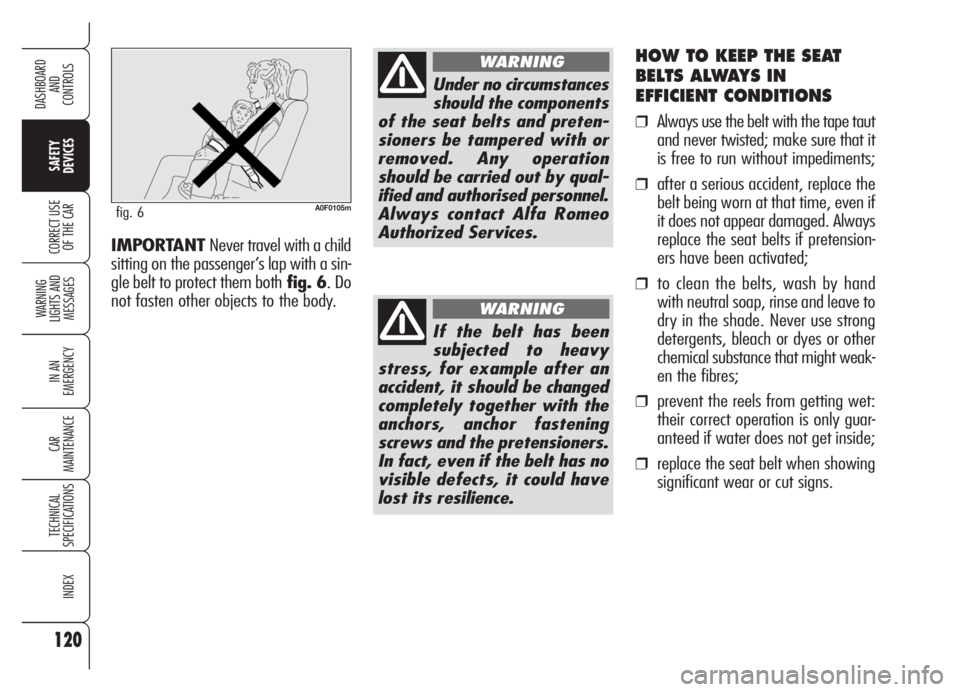
120
SAFETY
DEVICES
WARNING
LIGHTS AND
MESSAGES
IN AN
EMERGENCY
CAR
MAINTENANCE
TECHNICAL
SPECIFICATIONS
INDEX
DASHBOARD
AND
CONTROLS
CORRECT USE
OF THE CAR
HOW TO KEEP THE SEAT
BELTS ALWAYS IN
EFFICIENT CONDITIONS
❒Always use the belt with the tape taut
and never twisted; make sure that it
is free to run without impediments;
❒after a serious accident, replace the
belt being worn at that time, even if
it does not appear damaged. Always
replace the seat belts if pretension-
ers have been activated;
❒to clean the belts, wash by hand
with neutral soap, rinse and leave to
dry in the shade. Never use strong
detergents, bleach or dyes or other
chemical substance that might weak-
en the fibres;
❒prevent the reels from getting wet:
their correct operation is only guar-
anteed if water does not get inside;
❒replace the seat belt when showing
significant wear or cut signs. IMPORTANT Never travel with a child
sitting on the passenger’s lap with a sin-
gle belt to protect them bothfig. 6. Do
not fasten other objects to the body.
A0F0105mfig. 6
Under no circumstances
should the components
of the seat belts and preten-
sioners be tampered with or
removed. Any operation
should be carried out by qual-
ified and authorised personnel.
Always contact Alfa Romeo
Authorized Services.
WARNING
If the belt has been
subjected to heavy
stress, for example after an
accident, it should be changed
completely together with the
anchors, anchor fastening
screws and the pretensioners.
In fact, even if the belt has no
visible defects, it could have
lost its resilience.
WARNING
Page 122 of 270
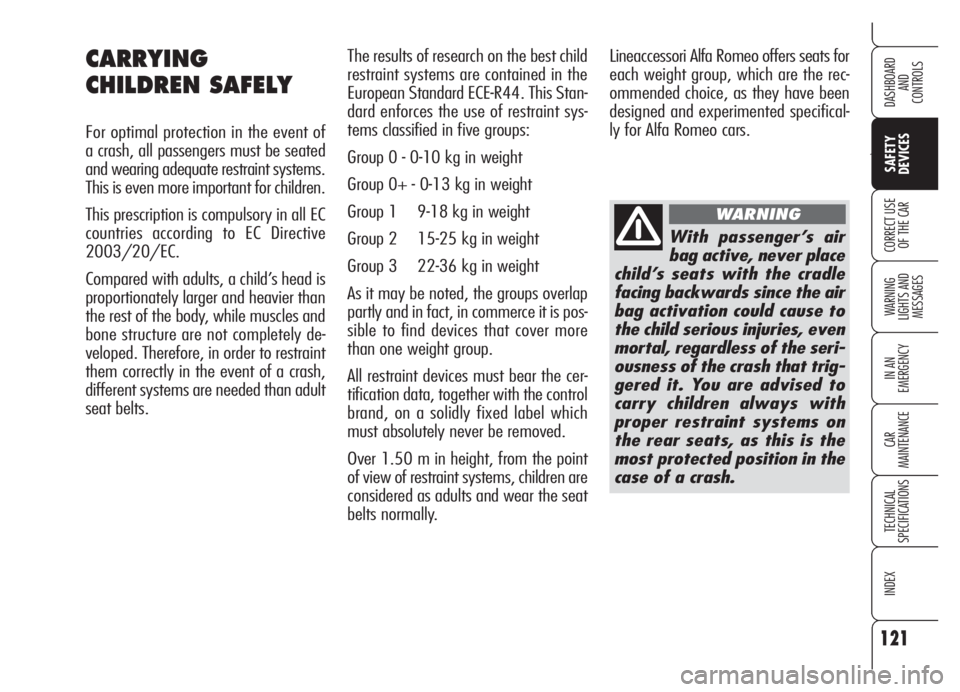
121
Ù
SAFETY
DEVICES
WARNING
LIGHTS AND
MESSAGES
IN AN
EMERGENCY
CAR
MAINTENANCE
TECHNICAL
SPECIFICATIONS
INDEX
DASHBOARD
AND
CONTROLS
CORRECT USE
OF THE CAR
The results of research on the best child
restraint systems are contained in the
European Standard ECE-R44. This Stan-
dard enforces the use of restraint sys-
tems classified in five groups:
Group 0 - 0-10 kg in weight
Group 0+ - 0-13 kg in weight
Group 1 9-18 kg in weight
Group 2 15-25 kg in weight
Group 3 22-36 kg in weight
As it may be noted, the groups overlap
partly and in fact, in commerce it is pos-
sible to find devices that cover more
than one weight group.
All restraint devices must bear the cer-
tification data, together with the control
brand, on a solidly fixed label which
must absolutely never be removed.
Over 1.50 m in height, from the point
of view of restraint systems, children are
considered as adults and wear the seat
belts normally.Lineaccessori Alfa Romeo offers seats for
each weight group, which are the rec-
ommended choice, as they have been
designed and experimented specifical-
ly for Alfa Romeo cars.CARRYING
CHILDREN SAFELY
For optimal protection in the event of
a crash, all passengers must be seated
and wearing adequate restraint systems.
This is even more important for children.
This prescription is compulsory in all EC
countries according to EC Directive
2003/20/EC.
Compared with adults, a child’s head is
proportionately larger and heavier than
the rest of the body, while muscles and
bone structure are not completely de-
veloped. Therefore, in order to restraint
them correctly in the event of a crash,
different systems are needed than adult
seat belts.
With passenger’s air
bag active, never place
child’s seats with the cradle
facing backwards since the air
bag activation could cause to
the child serious injuries, even
mortal, regardless of the seri-
ousness of the crash that trig-
gered it. You are advised to
carry children always with
proper restraint systems on
the rear seats, as this is the
most protected position in the
case of a crash.
WARNING
Page 123 of 270
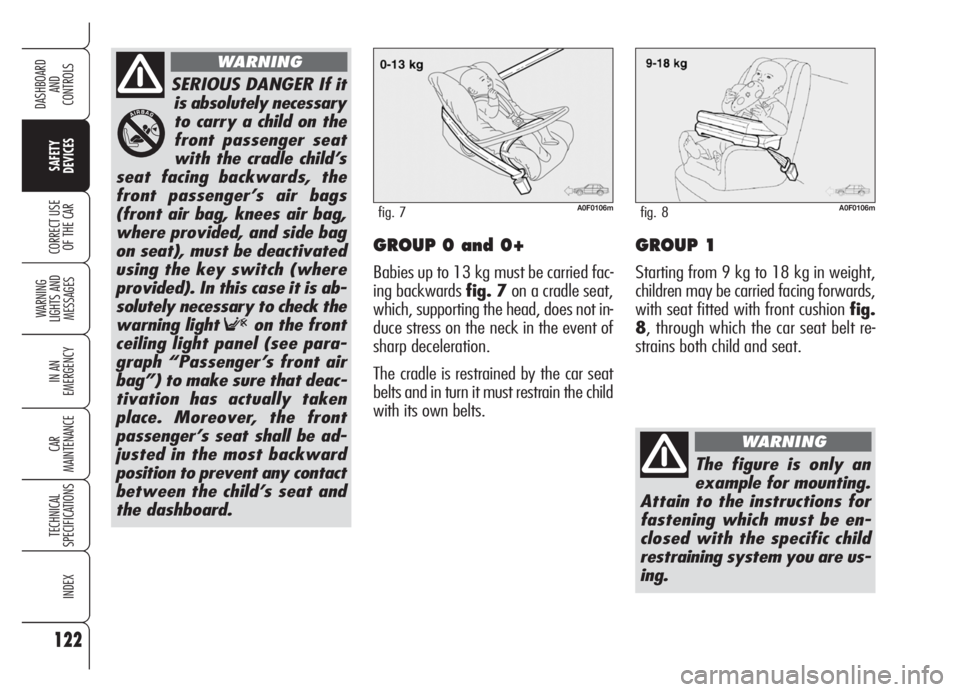
122
SAFETY
DEVICES
WARNING
LIGHTS AND
MESSAGES
IN AN
EMERGENCY
CAR
MAINTENANCE
TECHNICAL
SPECIFICATIONS
INDEX
DASHBOARD
AND
CONTROLS
CORRECT USE
OF THE CARGROUP 0 and 0+
Babies up to 13 kg must be carried fac-
ing backwards fig. 7on a cradle seat,
which, supporting the head, does not in-
duce stress on the neck in the event of
sharp deceleration.
The cradle is restrained by the car seat
belts and in turn it must restrain the child
with its own belts.
SERIOUS DANGER If it
is absolutely necessary
to carry a child on the
front passenger seat
with the cradle child’s
seat facing backwards, the
front passenger’s air bags
(front air bag, knees air bag,
where provided, and side bag
on seat), must be deactivated
using the key switch (where
provided). In this case it is ab-
solutely necessary to check the
warning light
Fon the front
ceiling light panel (see para-
graph “Passenger’s front air
bag”) to make sure that deac-
tivation has actually taken
place. Moreover, the front
passenger’s seat shall be ad-
justed in the most backward
position to prevent any contact
between the child’s seat and
the dashboard.
WARNING
A0F0106mfig. 7
The figure is only an
example for mounting.
Attain to the instructions for
fastening which must be en-
closed with the specific child
restraining system you are us-
ing.
WARNING
A0F0106mfig. 8
GROUP 1
Starting from 9 kg to 18 kg in weight,
children may be carried facing forwards,
with seat fitted with front cushion fig.
8, through which the car seat belt re-
strains both child and seat.
Page 124 of 270

123
Ù
SAFETY
DEVICES
WARNING
LIGHTS AND
MESSAGES
IN AN
EMERGENCY
CAR
MAINTENANCE
TECHNICAL
SPECIFICATIONS
INDEX
DASHBOARD
AND
CONTROLS
CORRECT USE
OF THE CARGROUP 2
Starting from 15 kg to 25 kg in weight,
children may be restrained directly by
the car belts. The only function of the
seat is to position the child correctly in
relation to the belts, so that the diago-
nal part adheres to the chest and not
to the neck and that the horizontal part
clings to the child’s pelvis and not the
abdomenfig. 9.
GROUP 3
For children from 22 kg to 36 kg the
size of the child’s chest no longer re-
quires a support to space the child’s back
from the seat back.Fig. 10shows
proper child seat positioning on the rear
seat.
Children taller than 1.50 m can wear
seat belts like adults.
Seats exist which are
suitable for covering
weight groups 0 and 1 with a
rear connection to the car belts
and their own belts to restrain
the child. Due to their size,
they can be dangerous if in-
stalled incorrectly fastened to
the car belts with a cushion.
Carefully follow the instruc-
tions for installation provided
with the seat.
WARNING
A0F0108mfig. 9A0F0109mfig. 10
The illustrations are in-
dicative only for as-
sembly. Assemble the seat ac-
cording to the compulsory in-
structions provided with it.
WARNING
Page 125 of 270
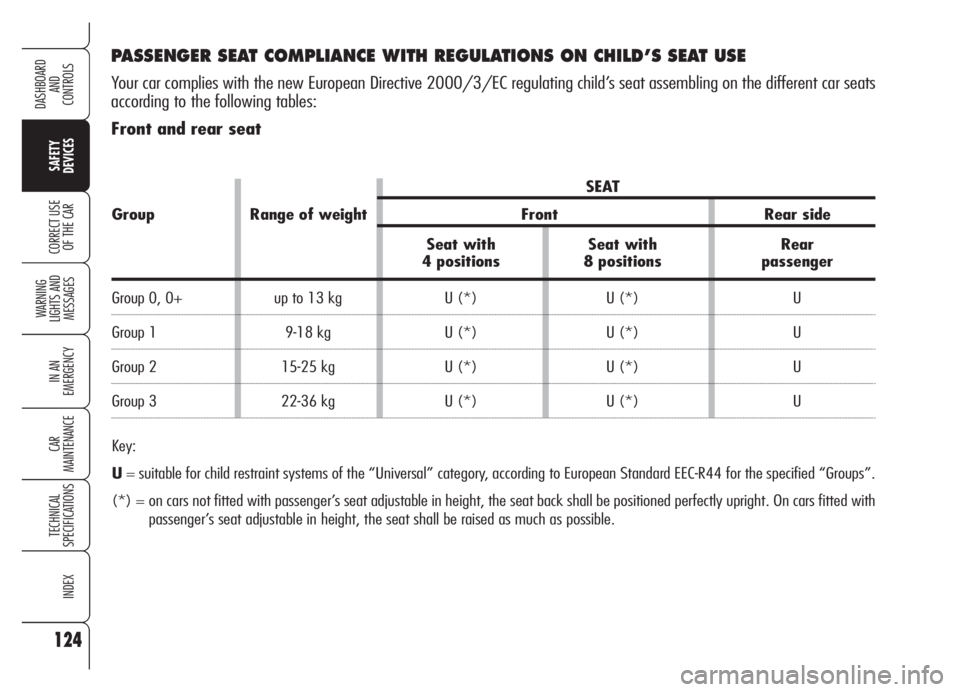
124
SAFETY
DEVICES
WARNING
LIGHTS AND
MESSAGES
IN AN
EMERGENCY
CAR
MAINTENANCE
TECHNICAL
SPECIFICATIONS
INDEX
DASHBOARD
AND
CONTROLS
CORRECT USE
OF THE CAR
PASSENGER SEAT COMPLIANCE WITH REGULATIONS ON CHILD’S SEAT USE
Your car complies with the new European Directive 2000/3/EC regulating child’s seat assembling on the different car seats
according to the following tables:
Front and rear seat
SEAT
Group Range of weight Front Rear side
Seat with Seat with Rear
4 positions 8 positions passenger
Group 0, 0+ up to 13 kg U (*) U (*) U
Group 1 9-18 kg U (*) U (*) U
Group 2 15-25 kg U (*) U (*) U
Group 3 22-36 kg U (*) U (*) U
Key:
U= suitable for child restraint systems of the “Universal” category, according to European Standard EEC-R44 for the specified “Groups”.
(*) = on cars not fitted with passenger’s seat adjustable in height, the seat back shall be positioned perfectly upright. On cars fitted with
passenger’s seat adjustable in height, the seat shall be raised as much as possible.
Page 126 of 270
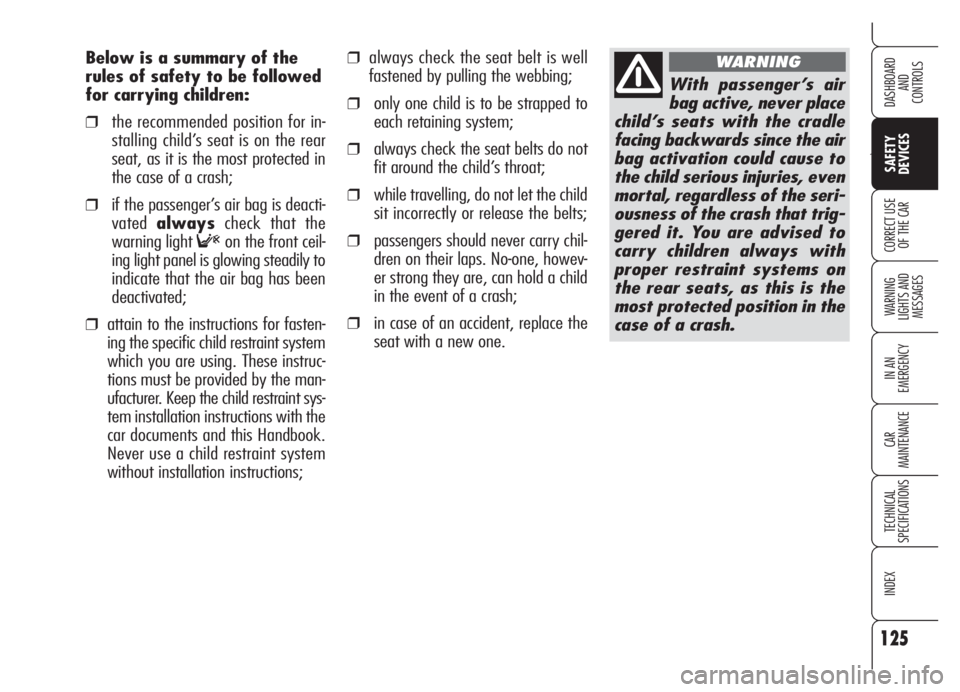
125
Ù
SAFETY
DEVICES
WARNING
LIGHTS AND
MESSAGES
IN AN
EMERGENCY
CAR
MAINTENANCE
TECHNICAL
SPECIFICATIONS
INDEX
DASHBOARD
AND
CONTROLS
CORRECT USE
OF THE CAR
❒always check the seat belt is well
fastened by pulling the webbing;
❒only one child is to be strapped to
each retaining system;
❒always check the seat belts do not
fit around the child’s throat;
❒while travelling, do not let the child
sit incorrectly or release the belts;
❒passengers should never carry chil-
dren on their laps. No-one, howev-
er strong they are, can hold a child
in the event of a crash;
❒in case of an accident, replace the
seat with a new one. Below is a summary of the
rules of safety to be followed
for carrying children:
❒the recommended position for in-
stalling child’s seat is on the rear
seat, as it is the most protected in
the case of a crash;
❒if the passenger’s air bag is deacti-
vatedalwayscheck that the
warning light
Fon the front ceil-
ing light panel is glowing steadily to
indicate that the air bag has been
deactivated;
❒attain to the instructions for fasten-
ing the specific child restraint system
which you are using. These instruc-
tions must be provided by the man-
ufacturer. Keep the child restraint sys-
tem installation instructions with the
car documents and this Handbook.
Never use a child restraint system
without installation instructions;
With passenger’s air
bag active, never place
child’s seats with the cradle
facing backwards since the air
bag activation could cause to
the child serious injuries, even
mortal, regardless of the seri-
ousness of the crash that trig-
gered it. You are advised to
carry children always with
proper restraint systems on
the rear seats, as this is the
most protected position in the
case of a crash.
WARNING
Page 127 of 270
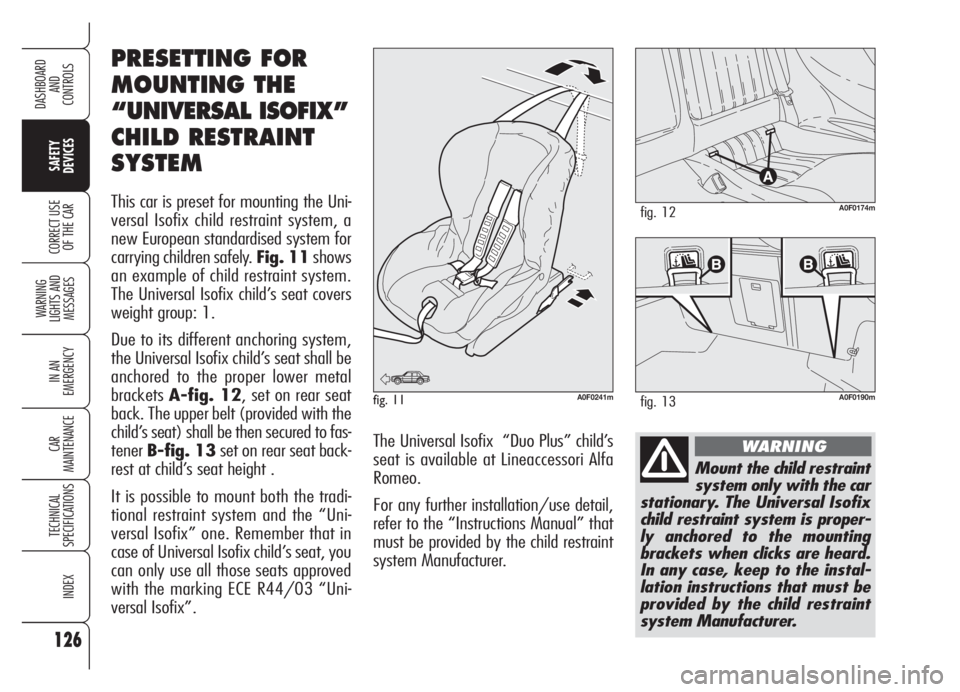
126
SAFETY
DEVICES
WARNING
LIGHTS AND
MESSAGES
IN AN
EMERGENCY
CAR
MAINTENANCE
TECHNICAL
SPECIFICATIONS
INDEX
DASHBOARD
AND
CONTROLS
CORRECT USE
OF THE CAR
Mount the child restraint
system only with the car
stationary. The Universal Isofix
child restraint system is proper-
ly anchored to the mounting
brackets when clicks are heard.
In any case, keep to the instal-
lation instructions that must be
provided by the child restraint
system Manufacturer.
WARNING
PRESETTING FOR
MOUNTING THE
“UNIVERSAL ISOFIX”
CHILD RESTRAINT
SYSTEM
This car is preset for mounting the Uni-
versal Isofix child restraint system, a
new European standardised system for
carrying children safely. Fig. 11shows
an example of child restraint system.
The Universal Isofix child’s seat covers
weight group: 1.
Due to its different anchoring system,
the Universal Isofix child’s seat shall be
anchored to the proper lower metal
bracketsA-fig. 12, set on rear seat
back. The upper belt (provided with the
child’s seat) shall be then secured to fas-
tenerB-fig. 13set on rear seat back-
rest at child’s seat height .
It is possible to mount both the tradi-
tional restraint system and the “Uni-
versal Isofix” one. Remember that in
case of Universal Isofix child’s seat, you
can only use all those seats approved
with the marking ECE R44/03 “Uni-
versal Isofix”.The Universal Isofix “Duo Plus” child’s
seat is available at Lineaccessori Alfa
Romeo.
For any further installation/use detail,
refer to the “Instructions Manual” that
must be provided by the child restraint
system Manufacturer.A0F0174mfig. 12
fig. 11A0F0241mA0F0190mfig. 13
Page 128 of 270
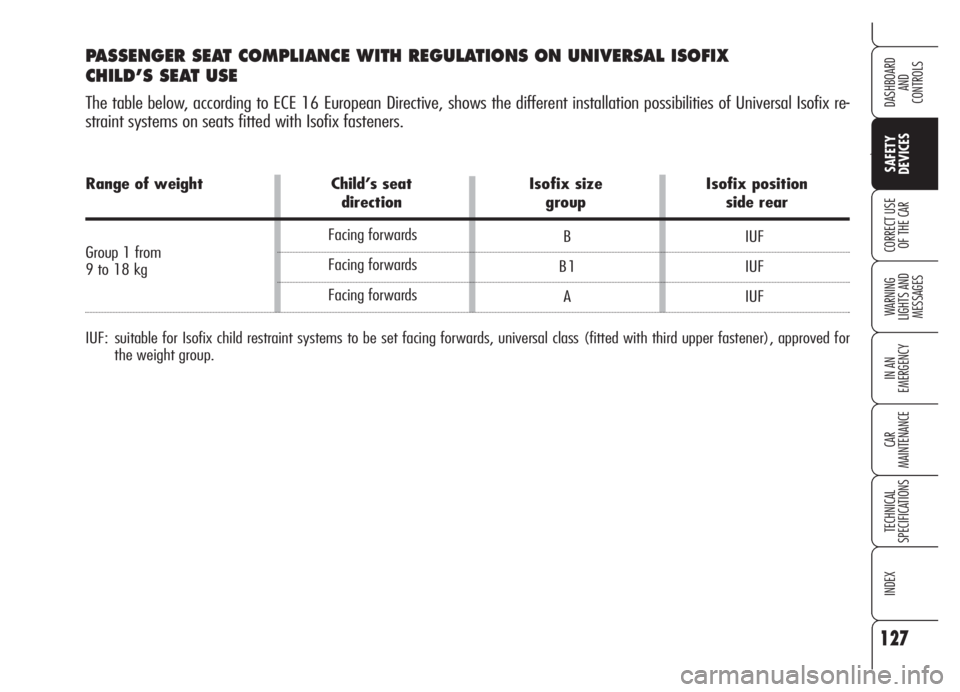
Range of weight Child’s seat Isofix size Isofix position
direction group side rear
Group 1 from
9 to 18 kg
127
Ù
SAFETY
DEVICES
WARNING
LIGHTS AND
MESSAGES
IN AN
EMERGENCY
CAR
MAINTENANCE
TECHNICAL
SPECIFICATIONS
INDEX
DASHBOARD
AND
CONTROLS
CORRECT USE
OF THE CAR
IUF: suitable for Isofix child restraint systems to be set facing forwards, universal class (fitted with third upper fastener), approved for
the weight group.
PASSENGER SEAT COMPLIANCE WITH REGULATIONS ON UNIVERSAL ISOFIX
CHILD’S SEAT USE
The table below, according to ECE 16 European Directive, shows the different installation possibilities of Universal Isofix re-
straint systems on seats fitted with Isofix fasteners.
B
B1
AIUF
IUF
IUF Facing forwards
Facing forwards
Facing forwards
Page 129 of 270
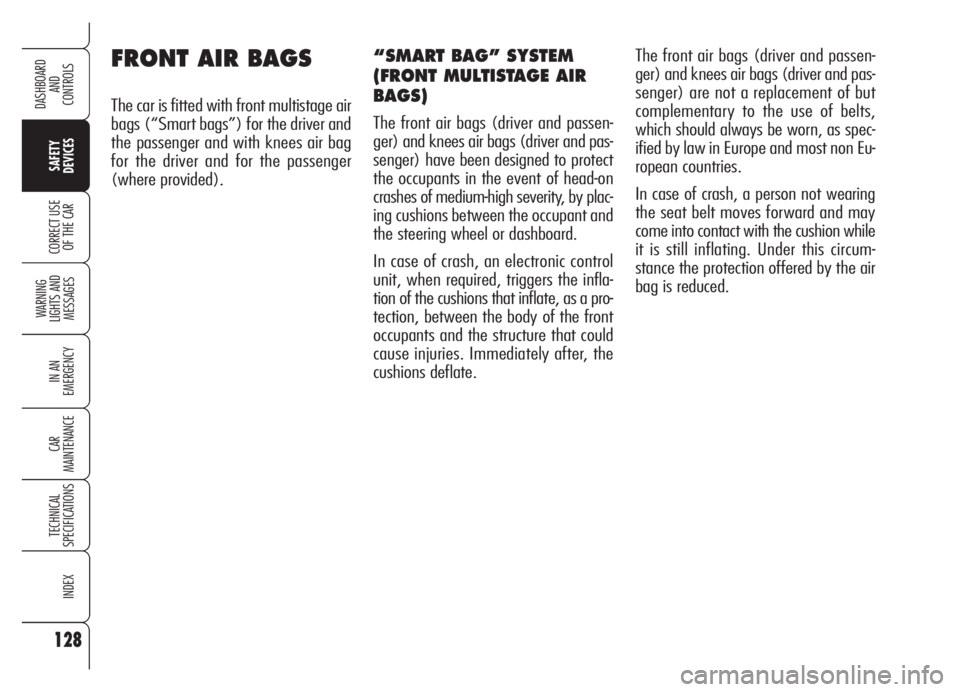
128
SAFETY
DEVICES
WARNING
LIGHTS AND
MESSAGES
IN AN
EMERGENCY
CAR
MAINTENANCE
TECHNICAL
SPECIFICATIONS
INDEX
DASHBOARD
AND
CONTROLS
CORRECT USE
OF THE CAR
FRONT AIR BAGS
The car is fitted with front multistage air
bags (“Smart bags”) for the driver and
the passenger and with knees air bag
for the driver and for the passenger
(where provided).The front air bags (driver and passen-
ger) and knees air bags (driver and pas-
senger) are not a replacement of but
complementary to the use of belts,
which should always be worn, as spec-
ified by law in Europe and most non Eu-
ropean countries.
In case of crash, a person not wearing
the seat belt moves forward and may
come into contact with the cushion while
it is still inflating. Under this circum-
stance the protection offered by the air
bag is reduced.
“SMART BAG” SYSTEM
(FRONT MULTISTAGE AIR
BAGS)
The front air bags (driver and passen-
ger) and knees air bags (driver and pas-
senger) have been designed to protect
the occupants in the event of head-on
crashes of medium-high severity, by plac-
ing cushions between the occupant and
the steering wheel or dashboard.
In case of crash, an electronic control
unit, when required, triggers the infla-
tion of the cushions that inflate, as a pro-
tection, between the body of the front
occupants and the structure that could
cause injuries. Immediately after, the
cushions deflate.
Page 130 of 270
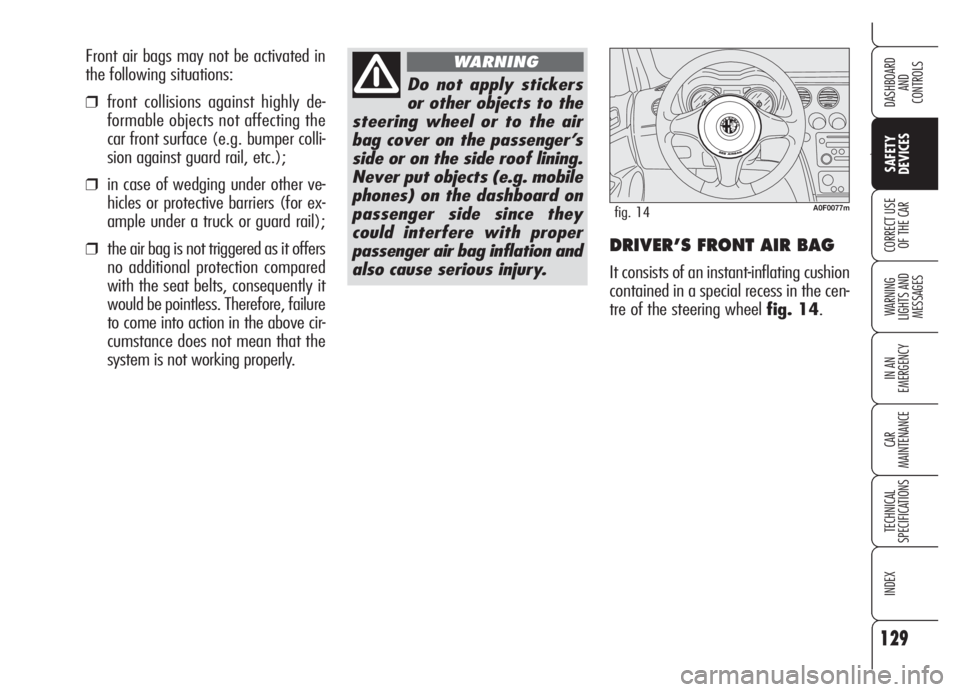
129
Ù
SAFETY
DEVICES
WARNING
LIGHTS AND
MESSAGES
IN AN
EMERGENCY
CAR
MAINTENANCE
TECHNICAL
SPECIFICATIONS
INDEX
DASHBOARD
AND
CONTROLS
CORRECT USE
OF THE CARDRIVER’S FRONT AIR BAG
It consists of an instant-inflating cushion
contained in a special recess in the cen-
tre of the steering wheelfig. 14. Front air bags may not be activated in
the following situations:
❒front collisions against highly de-
formable objects not affecting the
car front surface (e.g. bumper colli-
sion against guard rail, etc.);
❒in case of wedging under other ve-
hicles or protective barriers (for ex-
ample under a truck or guard rail);
❒the air bag is not triggered as it offers
no additional protection compared
with the seat belts, consequently it
would be pointless. Therefore, failure
to come into action in the above cir-
cumstance does not mean that the
system is not working properly.
Do not apply stickers
or other objects to the
steering wheel or to the air
bag cover on the passenger’s
side or on the side roof lining.
Never put objects (e.g. mobile
phones) on the dashboard on
passenger side since they
could interfere with proper
passenger air bag inflation and
also cause serious injury.
WARNING
A0F0077mfig. 14